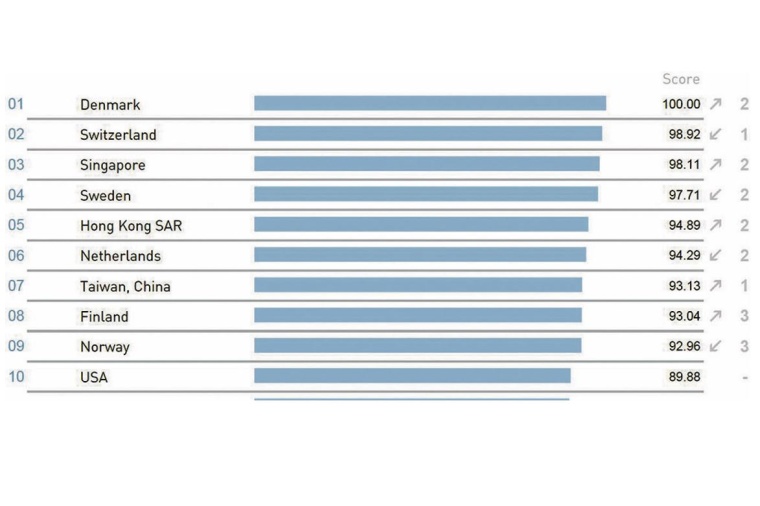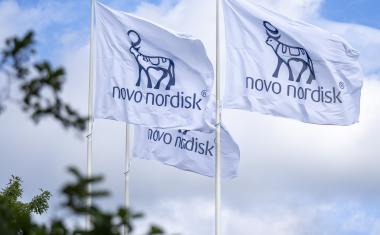The Re-Emergence of Global Geopolitical Risks
The 2022 edition of the IMD World Competitiveness Yearbook, compiled by the International Institute for Management Development (IMD), is published at a moment of tremendous turmoil.

The pandemic has affected all countries worldwide by giving rise to a health and economic crises. While Covid-19 is still affecting large parts of the world an additional perilous situation has emerged: the geopolitical risks re-introduced by the Russian invasion of Ukraine.
For this year’s edition of the report, IMD has evaluated the competitiveness standings of 63 countries and how their economies developed since 2021. The results for the ten most successful countries are presented as follows.
Competitiveness of High-Ranking Economies
The variation in the overall competitiveness ranking among the ten highest ranking countries in IMD’s report is presented in Fig. 1.
Denmark reaches the top spot (up from 3rd) for the first time in the history of the IMD World Competitiveness Ranking. Switzerland moves down to 2nd (from 1st), Singapore recovers to 3rd place (from 5th), Sweden declines to 4th (from 2nd) and Hong Kong improves to 5th (from 7th). While the Netherlands loses two places by dropping to 6th (from 4th), Taiwan gains one spot (up to 7th from 8th) and Finland joins the top 10 for the first time since 2009 reaching 8th position (from 11th). Norway declines from 6th to 9th and the USA once again rounds up the top 10.
Denmark
Denmark’s achievement is mainly due to gains in the International Investment sub-factor, and a robust performance in the Government Efficiency (6th) factor, particularly in the Institutional Framework (2nd), Business Legislation (3rd) and Societal Framework (2nd) sub-factors. The country performs outstandingly in the Business Efficiency factor (1st) and sub-factors such as Productivity and Efficiency (1st) and Management Practices (1st); it also improves in Attitudes and Values (6th to 3rd). Denmark reaches 2nd place in the Infrastructure factor advancing in the Technological Infrastructure (6th to 3rd) and Scientific Infrastructure (11th to 10th) sub-factors but losing one place in Education (4th).
Switzerland
Switzerland’s performance remains strong despite its slight drop in the overall ranking. It tops the Government Efficiency and Infrastructure factors and ranks 4th in Business Efficiency. The downturn in the overall ranking originates largely from a sharp decline in the International Investment sub-factor and, to a lesser extent, in the Employment sub-factor, which places the country in the 30th spot in the Economic Performance factor. However, it improves in International Trade (15th to 12th). In Government Efficiency, there are slight drops in Public Finance (1st to 3rd) and Societal Framework (5th to 6th), but Switzerland remains 1st in the Institutional Framework sub-factor. The improvement in the Business Efficiency factor (5th to 4th) is largely due to gains in Productivity and Efficiency (4th to 2nd) and Labor Market (6th to 5th). However, it is worth noting that the country’s performance in the Attitudes and Values sub-factor remains moderately low at 14th.
Singapore
Singapore’s recovery stems from strong improvements in Domestic Economy (1st from 15th), Employment (3rd from 18th), Public Finance (6th from 12th), and Productivity and Efficiency (9th from 14th). Slight gains in Business Legislation (2nd from 3rd) and Education (6th from 7th) also contribute to its recovery. In addition, Singapore’s performance in the International Trade and Technological Infrastructure sub-factors remain robust; it ranks 1st in both. However, Singapore remains in relatively low positions in several sub-factors including Management Practices (14th) Scientific Infrastructure (16th) and Health and Environment (25th). In others, it experiences some declines: Societal Framework (17th to 22nd), Labor Market (4th to 12th) and Attitudes and Values (9th to 12th).
Sweden
Sweden’s decline results from a slowdown in measures of Economic Performance such as the Domestic Economy, International Trade and Employment sub-factors. Trade and Employment, in particular, show a sharp decline. Sweden’s performance in the Government and Business Efficiency factors remain stable placing 9th and 2nd, respectively. That said, when it comes to Government Efficiency, there are some declines; for example, in Public Finance (9th down from 7th) and Societal Framework (down to 5th from 4th). Similarly, in Business Efficiency the Productivity and Efficiency sub-factor experiences a slight drop (to 4th from 3rd) but Finance (3rd) and Attitudes and Values (2nd) improve. Within the Infrastructure factor (3rd), Sweden experiences some slight declines; for example, in Technological Infrastructure (5th from 3rd), Health and Environment (2nd from 1st) and Education (5th from 4th).
Hong Kong
The recapturing of a top 5 spot by Hong Kong has its origins in Economic Performance (15th), particularly in the International Trade (4th) and International Investment (3rd) sub-factors. It experiences a slight decline in the Government Efficiency (2nd) factor despite improvements in the Public Finance sub-factor (up to 2nd from 9th). However, it remains relatively low in the Societal Framework sub-factor (33rd). In the Business Efficiency factor Hong Kong falls to 7th (from 3rd) mainly because of sharp declines in the Labor Market (20th from 8th) and Attitudes and Values (16th from 8th) sub-factors. Its performance in the Infrastructure factor (14th from 16th) remains relatively stable, showing some gains in Health and Environment (21st to 18th) but dropping from 8th to 13th in Education.
The Netherlands
The drop in the overall ranking experienced by the Netherlands is due to a significant downturn in the Economic Performance factor (19th). This decline results from slumps in Domestic Economy (25th), International Investment (46th), Prices (52nd) and — to a lesser extent — in the Employment sub-factor (7th). Elsewhere, the Netherlands continues to perform strongly, remaining in 12th place in Government Efficiency and slightly improving in both Business Efficiency (to 3rd from 4th) and Infrastructure (to 5th from 7th).
Taiwan
Taiwan’s improvement is due to a stable performance in the Government Efficiency factor which is the result of improvements in Tax Policy (6th from 11th), and one-rank gains in both Institutional Framework (8th) and Business Legislation (21st). There is, however, a noteworthy drop in the Public Finance sub-factor (4th to 10th). In the Business Efficiency factor, it improves one spot to 6th due to increases in Productivity and Efficiency (13th to 8) and Finance (11th to 8th). It remains 5th in Management Practices. Taiwan also advances in Infrastructure (14th to 13th) by improving in Technological Infrastructure (9th from 10th) and by steady performing steadily in Scientific Infrastructure (6th) and Education (16th). However, it experiences a drop in Health and Environment at 26th (from 24th).
Finland
Despite a downturn in the Economic Performance factor (44th) due to drops in the Domestic Economy (36th), Employment (40th) and Prices (40th) sub-factors, Finland joins the top 10 this year. The improvement comes on the back of advances in the Government Efficiency factor (14th to 10th) particularly in Tax Policy (52nd from 59th), Institutional Framework (3rd from 6th), Business Legislation (6th from 12th) and Societal Framework where it reaches 1st spot. Finland’s performance in the Business Efficiency factor is similar rising to 5th (from 12th) due to advancements in all of its sub-factors, most notably in Labor Market (from 24th to 18th) and Attitudes and Values (from 14th to 5th). In the Infrastructure factor, Finland rises to 4th (from 5th) by improving in all of this factor’s components with the largest increases in Basic Infrastructure (from 11th to 6th) and Scientific Infrastructure (from 15th to 12th). It ranks in the top 3 in the rest of the sub-factors.
Norway
Norway’s decline in the overall ranking is the result of a downward trend in three of the four competitiveness factors. Although it remains in 25th place in the Economic Performance factor, its performance falls in the Domestic Economy sub-factor (28th), as well as in the International Investment (22nd), Employment (18th) and Prices (44th) sub-factors. Within the Government Efficiency factor, where Norway slightly declines to 5th (from 4th), it drops in Institutional Framework (5th), Business Legislation (10th) and Societal Framework (4th) but increases seven spots in Public Finance to reach 1st place. In Business Efficiency, Norway experiences a downturn from 6th to 10th as it drops in all sub-factors, the largest declines being in Management Practices (17th) and Attitudes and Values (18th). An exception is in the Labor Market sub-factor where it increases from 11th to 10th. In Infrastructure, it also falls from 4th to 6th because its performance declines in all of the factor’s components with the largest drop being in Education (from 6th to 10th).
USA
In the overall ranking, the USA remains in 10th place, despite some notable declines at the sub-factor level. For example, its performance in International Trade (41st), Institutional Framework (23rd), Management Practices (15th) and Technological Infrastructure (11th) deteriorates. The country’s rankings in other sub-factors remain low, such as in Public Finance (53rd), Societal Framework (40th) and Attitudes and Values (26th). Despite these trends, the USA reaches the top place in International Investment and remains 1st in Scientific Infrastructure. The country also advances in other areas, including the Employment (10th) and Labor Market (23rd) sub-factors.
What does the future hold?
For the last couple of years, IMD’s analysis has focused on the health and economic crises that have been brought about by the pandemic. However, they have always claimed that that the fundamentals of competitiveness have remained the same, even under turbulent conditions. According to IMD, the institutional framework, the rule of law, infrastructure and education — the pillars of competitiveness — were relatively intact. The question is: Will this remain the case after the re-emergence of global geopolitical risks?

This article presents some of the findings of the IMD World Competitiveness Yearbook 2022, issued by the International Institute for Management Development (IMD) via its IMD World Competitiveness Center in Switzerland. The complete report is available at www.imd.org/wcc.
















